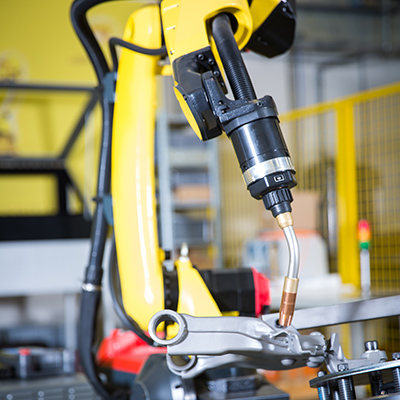FANUC showcased its laser welding system at the “Schweißen & Schneiden” trade fair in Düsseldorf

Photo by FANUC Luxembourg Corporation
A great deal of practice and forward-looking technology point FANUC to “Schweißen & Schneiden” [Welding & Cutting] in Düsseldorf 2017 (Hall 13, Stand B31). The selection of robot cells for different welding applications, the presentation of combinations of fibre lasers and robots as well as the introductory package for welding training demonstrate practical relevance and technological expertise.
FANUC introduced for the first time at the trade fair in Düsseldorf a laser welding system developed together with FFT, using a FANUC FF 6000i-A fibre laser with 6 kW laser power. While a FANUC R-2000iC/165F robot laser welds a mock-up of automotive component, a M-20iA/35M robot is used to feed parts, loading and unloading the cabin fixture. FANUC, through the conceptual study of the laser cell, has extended its range of applications in the field of cutting to the constantly growing field of laser welding, particularly in the automobile industry. The fibre laser used is currently the most powerful laser from FANUC; this series of lasers is scaled in kW increments, down to the smallest beam source with 1 kW. They work with a wavelength of 1.064 µm.
FANUC displays the new ARC Mate 100iD welding robot in a compact welding cell featuring a 2-axis 500kg positioner and the new Servo-Robot FujiCam laser sensor able to perform both seam tracking and post-weld seam inspection. The new fully integrated robot dressout eliminates any interference with peripheral equipment or fixtures giving peace of mind in offline programming and improving service ability by reducing the burden of external cabling.
In another cell, FANUC showed the combination of laser and DualArm technology: Two M-710iC/50 robots work together on the three-dimensional pipe cutting. In this process, one robot holds the pipe and the other robot, equipped with a Precitec cutting head, performs the cutting. Through the combination of robot/laser with a control system and the complete automation package, FANUC underlines its expertise in accordance with the company’s philosophy, “One FANUC”. Since FANUC develops and produces both fibre lasers as well as CO2 lasers itself, a user can select the suitable laser and highly integrated application packages to find the solution that best fits its tasks from the same source.
System integrator H. Euen, Berlin, brought along an eye-catcher to Essen, to present its cell at the FANUC stand. It is a cell without any workpiece fixture (“jigless welding”). An R-2000iC robot, with a 165 kg load capacity, it handles the part, while an ARC Mate 100iC/12 welds it. Using welding equipment from Lorch, the flexible welding is demonstrated on the frame of an E-Cart. Visitors could inspect the welding cell as well as the finished vehicle.
The DualArm MIG welding cell was certainly of particular interest for customers welding long parts or assemblies, such as exhaust pipes. In addition to the two robots, an H-positioner is controlled within the same robot system. The welding demo was demonstrated by two ARC Mate 100iC/8L robots using welding equipment from Fronius.
FANUC presented the new possibilities opened up for spot welding with an advanced R-1000iA/80F cell. The robot has a load capacity of 80kg, a maximum range of 2,230 mm and it’s the fastest in its class. The robot was presented in a spot welding application with lightweight and very fast gun called “SpeedGun 10K” developed by system integrator LEWA Attendorn.
The “Förster Welding Kart” seen for the first time at “Schweißen & Schneiden”. The kart was developed by welding specialist and system integrator Förster Welding Systems, Hohenstein-Ernstthal, in cooperation with FANUC. The kart is a mobile table which has been fully equipped for training purposes and which can be used both for commercial training as well as for study purposes.
For more information, please visit http://www.fanuc.eu.
News Categories
- » NEWS HOME
- » Automation & Robotics
- » Industry 4.0
- » Material Handling
- » Sensors
- » Quality & Testing
- » Machine Vision
- » Laser & Optics
- » Metalworking
- » Motion Control & Drives
- » Hydraulics & Pneumatics
- » Process Industry
- » Renewable Energy
- » Agriculture
- » Home & Office Furniture
- » Environmental Tech




